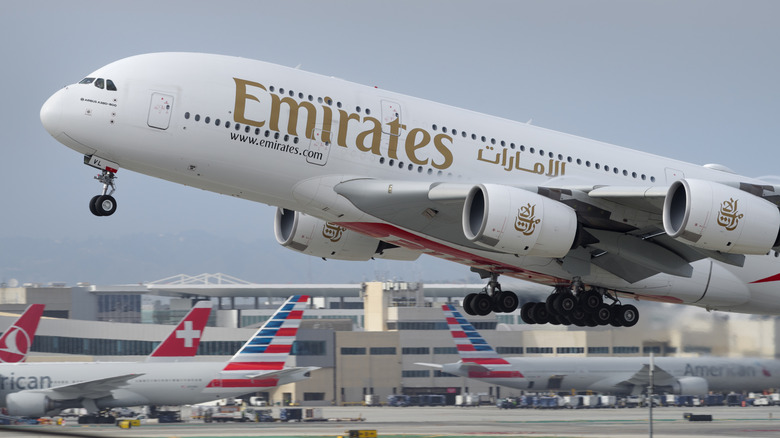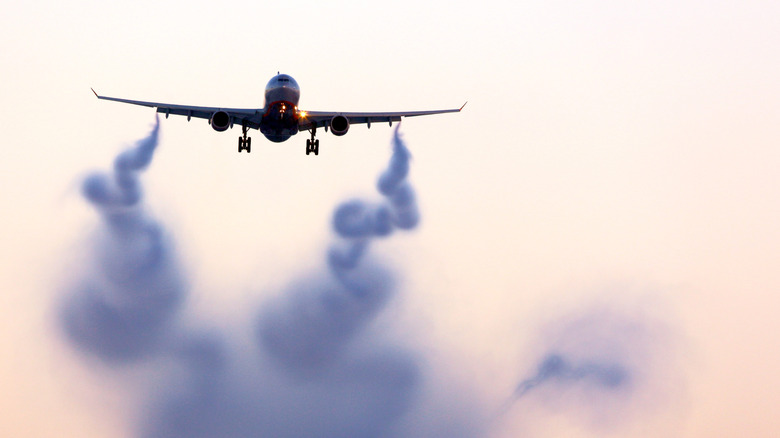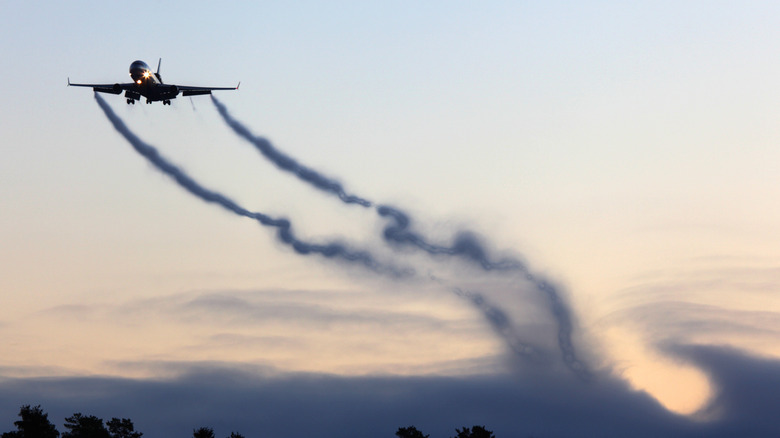What Is Wake Turbulence And How Does It Affect Air Traffic?
Turbulence is something that affects every aircraft in flight. However, the phenomenon known as wake turbulence not only affects aircraft, it's caused by them. Wake turbulence is generated by aircraft wing tips when they're cruising and from the edge of the outboard flaps when taking off or landing. This type of turbulence can be visualized as a pair of counter-rotating vortices that stream from the wing tips and outboard flaps.
How severe the turbulence will be is largely dictated by the size and shape of the aircraft. A modern passenger jet like the gigantic Airbus A380 will generate much more wake turbulence than a small passenger jet, for example. A heavier, slower aircraft will create proportionally more turbulence than a lighter, faster-moving jet. A "dirty configuration" (with the undercarriage and flaps extended) helps to break up the wake turbulence.
Wake turbulence can happen in any phase of a flight. However, the runway is where pilots and air traffic controllers have to exercise the most caution. But just how big of a problem is wake turbulence and how does it affect air traffic?
Wake turbulence and its effect on air traffic
One example that shows why wake turbulence is taken so seriously concerns a Bombardier Challenger 604 jet which had the misfortune of flying within 1,000 vertical feet of an Airbus A380. This David and Goliath meeting occurred high above the Arabian Sea and the turbulence was so severe that the jet dropped 9,000 feet and went through several rotations before the pilots managed to regain control. During the incident, two passengers were seriously injured and the jet was so badly damaged that Bombardier said (via the Flight Safety Foundation), "It could not be restored to an airworthy state." The rotations the plane went through are characteristic of the vortex shape of wake turbulence which is known to induce a rolling motion that can exceed the roll control of the affected jet.
Despite this harrowing tale, most incidents happen around airports where airspace is crowded. This is why busy commercial airports operate a minimum separation policy which aims to keep aircraft from encountering another jet's wake turbulence. How much separation is needed largely depends on the size of the aircraft in question. Passenger jets are rated as being super, heavy, medium, or light for wake turbulence purposes. This is what it means when a pilot says heavy; it references how much distance should be between aircraft.
Managing the risk of wake turbulence
Wake turbulence has been a factor in many in-flight incidents. The aforementioned Bombardier is one such case. Others include a Cessna Citation 550 that crashed when approaching a runway. The Cessna encountered the wake turbulence of a Boeing 757 jet, causing it to suddenly roll left and crash, tragically killing all eight passengers and crew. In another case, a Gulfstream IV jet hit wake turbulence that the pilot said was "like hitting a 20-foot thick concrete wall." In this instance, the plane landed safely, but there were injuries to passengers and crew.
These incidents demonstrate why managing the risk of wake turbulence is taken so seriously. The minimum separation rule is part of this strategy (known as RECAT), but there are other systems which help to mitigate the risk. Among these are plates at the end of runways which cancel out vortices, cloud radar systems that provide insights into wind direction and shearing, and infrared sensors. Pilots can also take steps to negate the risk. For instance, when landing, the pilot may choose to stay above the leading aircraft's flightpath, alter course to the upwind side of the aircraft, or land beyond the touchdown point of the leading aircraft.
In short, wake turbulence can have a dramatic effect on air traffic, both in terms of how airports schedule traffic and the potentially catastrophic effect on airborne planes. However, before cancelling your flight, it's worth remembering that air travel is still the safest form of travel.


